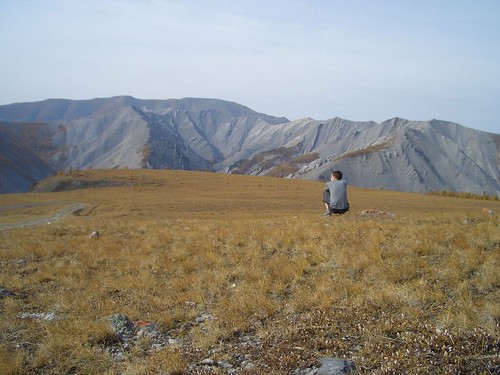I rented a minibus with four others; Beth, Lauren, Jeff, and Tracy. I met Beth & Lauren at my hotel one morning - they were having breakfast and I asked if I could join them. It's amazing how social you become when you are travelling alone... They had booked a minibus for 12/18, and there was one seat open. I stopped by the company and booked the last seat.
We set off at 4:30am on 12/18, since we had a long day of driving. It took about 1.5 hours to reach My Son, and we got stuck in mud en route. Luckily, a few Vietnamese construction workers helped us push the minibus out of the mud.
My Son was empty when we pulled up - it was worth the extra effort to get up early in order to beat the other tourists. I had mixed feelings about the site - it was great when the sun was low in the sky and we were the only people there. At that time, it seemed very mysterious & tranquil. As we walked around, an acute sense of shame & anger was welling up inside me. The US had bombed the area, and many of the ruins are REALLY ruined. I could only imagine how magical this place would have been if it were still intact. Just as we were leaving, a few groups of tourists had started to arrive - perfect timing!!
Upon arrival in China Beach, we were surrounded by young & old women trying to sell us handicrafts. All of us need some R&R, so we asked our driver to take us to a nearby resort. We wouldn't have to deal with as many people in our face - all we wanted to do was relax in the sun. $10 later, we were laying on a beach with 8 other tourists. We were at the Furama Beach Resort; some 5 star elitist hotel. I was disgusted at myself for paying $10 to escape the locals, but I needed the peace. The beach was deserted and locals weren't allowed on the beach. I felt like I had the place to myself - 500ft of beach (almost) all to myself. I was lounging around for awhile, and then borrowed a boogie board and went out into the surf. The lifeguard had warned me about staying close to shore, but I didn't understand why. After swimming out a ways, I was terrified. The current was so strong that I could swim as hard as I could and not move. Instead of swimming along the beach, I came much closer to shore. In total, I was in the water for 20 minutes until I was exhausted.
We ate at the resort's restaurant - $16 for all you can eat brunch. We hadn't shown any modesty; we ate like gluttons and paid for the meal like it wasn't a big deal. When we were preparing to leave, I was ashamed. I haven't lived a day in my life when I haven't had enough food or a soft, warm place to sleep. My country killed hundreds of thousands of their countrymen only 40 years ago, and now we return to flaunt our money, having these people wait on us like servants. What did the hotel employees think of us? I would really like an honest Vietnamese opinion of Westerners. Each of us had just spent about 25% of an average monthly Vietnamese income on breakfast.
I don't think the others thought much about this, as when I mentioned the cost of breakfast versus the Vietnamese monthly income, my statement was dismissed. I felt like my fellow travellers were raised with a silver spoon. On the way back from My Son, they were discussing California universities and recalling found memories of universities like Berkley. None of these people worked for their own education - it was provided by their parents. I ignored their conversation about a world very different from mine, and focused on the landscape rolling by.
After Furama Resort, we headed to Marble Mountain. I'm usually down for anything with 'mountain' in it, but this was mildly disappointing. There were caves filled with Buddha statues, but I had been expecting a bit more. Nevertheless, it was worth the trip since we were so close.
My flight to Saigon leaves tomorrow - then I fly out from Saigon late at night, and stay a few days in Tokyo. I can't wait to go back to Tokyo - I love it there. The huge buildings, the throngs of people, the food, the lights. It brings back good memories of the summer program that I attended at Sophia University.
